Submitted by WA Contents
Bauhaus and Metu among 12 modern buildings to receive conservation grants from the Getty Foundation
United States Architecture News - Aug 04, 2017 - 09:39 17982 views

The Getty Foundation has announced 12 significant 20th century buildings to receive 2017 grants, as part of its Keeping It Modern initiative. Among this year’s most recognizable projects is Germany’s Bauhaus Building, the premier example of modern architecture Middle East Technical University designed by Altuğ and Behruz Çinici, the revered Dessau structure designed by architect Walter Gropius, who incorporated design features that would ultimately become synonymous with modern architecture around the world.
This year, the Getty Foundation will grant $1.66 million to 12 significant modernist buildings for architectural conservation, which aims to "point the importance of research and planning for the preservation of modern architectural heritage."
Since its inception in 2014, Keeping It Modern has supported 45 international conservation projects. The selected 12 projects represent the work of innovative architects who pushed the boundaries of design and construction materials.
"Over the past three years, we have given 45 Keeping It Modern grants in 22 countries, and we bring together experts working on the conservation projects each summer to share their findings. Together our colleagues are building a critical body of knowledge for the stewardship of modern buildings," says Deborah Marrow, director of the Getty Foundation.
"This year’s 12 new projects, along with prior grants for landmarks all over the world, will provide models for the protection of modern architecture for future generations."
"A new theme evident in many of the 2017 grants is the pressing need to update 20th century buildings to meet 21st century demands," stated the Foundation.
This year’s grants also include the first project in Russia, a country that contributed greatly to the international development of modern architecture. Moscow’s Melnikov House is an excellent example of Soviet avant-garde architecture and is notable for its structural ingenuity.
Built as two intersecting cylinders that are free of interior walls, the house’s unconventional style reflects the boundary-pushing vision of architect Konstantin Melnikov, who designed the house as his studio and family residence.
The Getty grant comes at a time of renewed national interest in conservation planning as the building’s stewards prepare to increase visitorship to the home, and the resulting conservation plan can serve as a model for the preservation of other avant-garde monuments from the 1920s-1930s in the country.
Scroll down to see the 12 significant buildings with their short information:

Coventry Cathedral interior. Image © David Iliff. CC-BY-SA, 3.0, courtesy of Getty Foundation
Cathedral Church of St. Michael
Coventry Cathedral, Sir Basil Spence, 1962, Coventry, England
"Coventry Cathedral is both a celebrated example of 20th century architecture and a monument to the adjoined ruins of 500 year-old St. Michael’s Cathedral. During the German Luftwaffe’s devastating Coventry Blitz in November 1940, the Gothic church was decimated to a mere skeleton, with only the tower, spire, and a few outer walls left standing. In the bombing’s wake, the community of Coventry was left with the question of whether and how to rebuild, ultimately leading to an open competition. Sir Basil Spence’s daring, modern plan was a radical break from tradition, but was also the only design that incorporated and preserved the destroyed church."
"Consecrated in May 1962, Coventry Cathedral rapidly became a popular symbol of reconciliation in postwar Britain. Spence’s design fuses St. Michael’s remains with the modern structure using red sandstone walls, slender columns, minimally vaulted ceilings, and numerous bays of stained glass windows. The merging of the modern building with the ruins has resulted in a holy space where visitors and worshippers can experience the union of past and present."
Grant support: £132,000
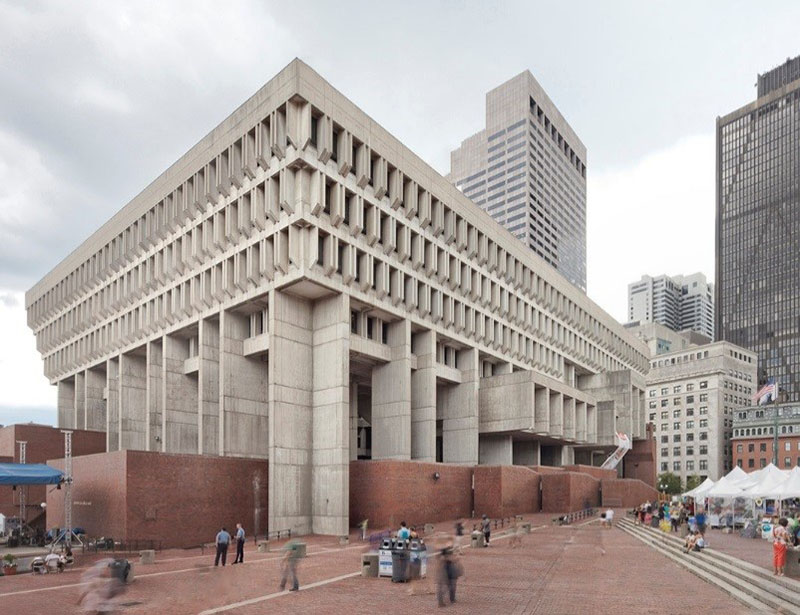
Boston - City Hall Plaza. Image © Naquib Hossain/Dotproduct Photography, courtesy of Getty Foundation
City of Boston
Boston City Hall, Kallmann, McKinnell, & Knowles, 1968, Boston, Massachusetts
"In 1962 a panel of judges defied expectations and awarded the design of Boston City Hall to the newly established firm of Gerhard Kallmann, Michael McKinnell, and Edward Knowles to execute a bold new vision of brutalist architecture. Grandly austere with its concrete facade, Boston City Hall features several playful gestures, including its gravity- defying mayor’s office that hovers over the main entrance plaza and a profusion of outsized classical dentils."
"The latter’s ironic reference to the city’s plethora of Greek-inspired municipal buildings underscores the architects’ intention to introduce a new idiom to Boston’s civic landscape. Although reception of the building has been mixed, the last several years have seen a shift in public sentiment, with many residents now embracing the site as a key feature of the city fabric."
Grant support: $120,000
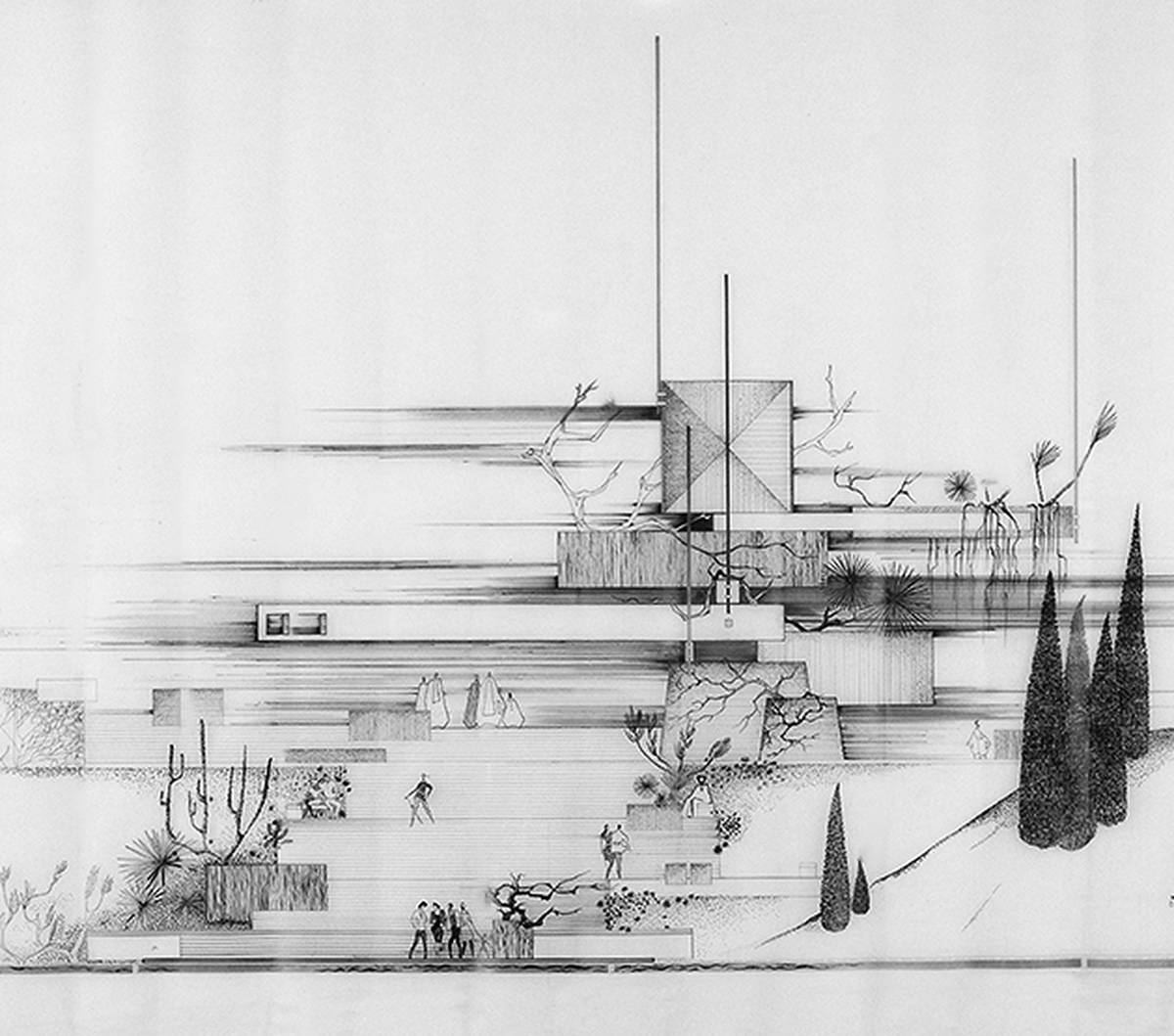
Station thermal, Sidi Harazem, 1960. Image © François Lauginie. Image © Frac Centre-Val de Loire Collection, courtesy of Getty Foundation
Fondation Caisse de Dépôt et de Gestion (CDG)
Sidi Harazem Thermal Bath Complex, Jean-François Zevaco, 1958, Sidi Harazem, Morocco
"Nestled in a Moroccan oasis where ancient mineral springs have drawn visitors for centuries, the Sidi Harazem Thermal Bath Complex represents a marriage of nature, public space, and modern architecture. Built four years after Moroccan independence, the complex is the ambitious statement of a new nation determined to create modern and forward-thinking gathering places for its citizens."
"In 1957, a state-owned pension fund commissioned Moroccan-born French architect Jean-François Zevaco to design the site. Opened a year later to widespread acclaim, the complex is Zevaco’s largest work and marks an early example of concepts that he would revisit throughout his prolific career."
Grant support: $150,000
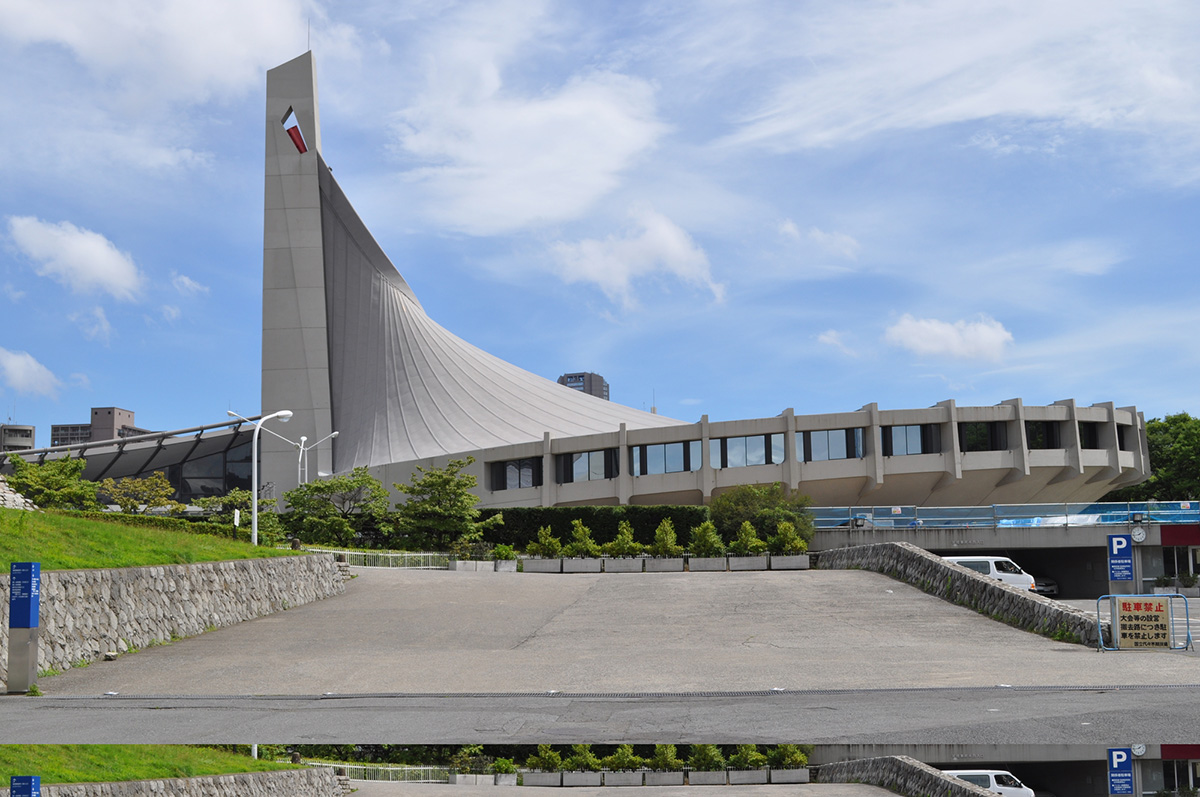
Second gymnasium of Yoyogi stadium. Image courtesy Japan Sport Council, courtesy of Getty Foundation
Japan Sport Council
Yoyogi National Gymnasium, Kenzo Tange, 1964, Tokyo, Japan
"When Japan was preparing to host the first-ever Olympic Games in Asia in the early 1960s, the state commissioned eventual Pritzker Prize-winning architect Kenzo Tange to build a pivotal venue for the event. Tange responded with the Yoyogi National Gymnasium, two elegant concrete and steel buildings that gained immediate international recognition as masterpieces of modern architecture when their doors opened in 1964."
"Yoyogi National Gymnasium’s state-of-the-art technology and exacting engineering, along with its elongated sweeping roofline, introduced a new modernism to Japan while still evoking the grace and timelessness of traditional Japanese architecture. With its spindle- or shell-like shape, Yoyogi National Gymnasium became a prime example of Japan’s Metabolist style, a postwar Japanese movement that explored architecture as a living and evolving organism."
Grant support: $150,000
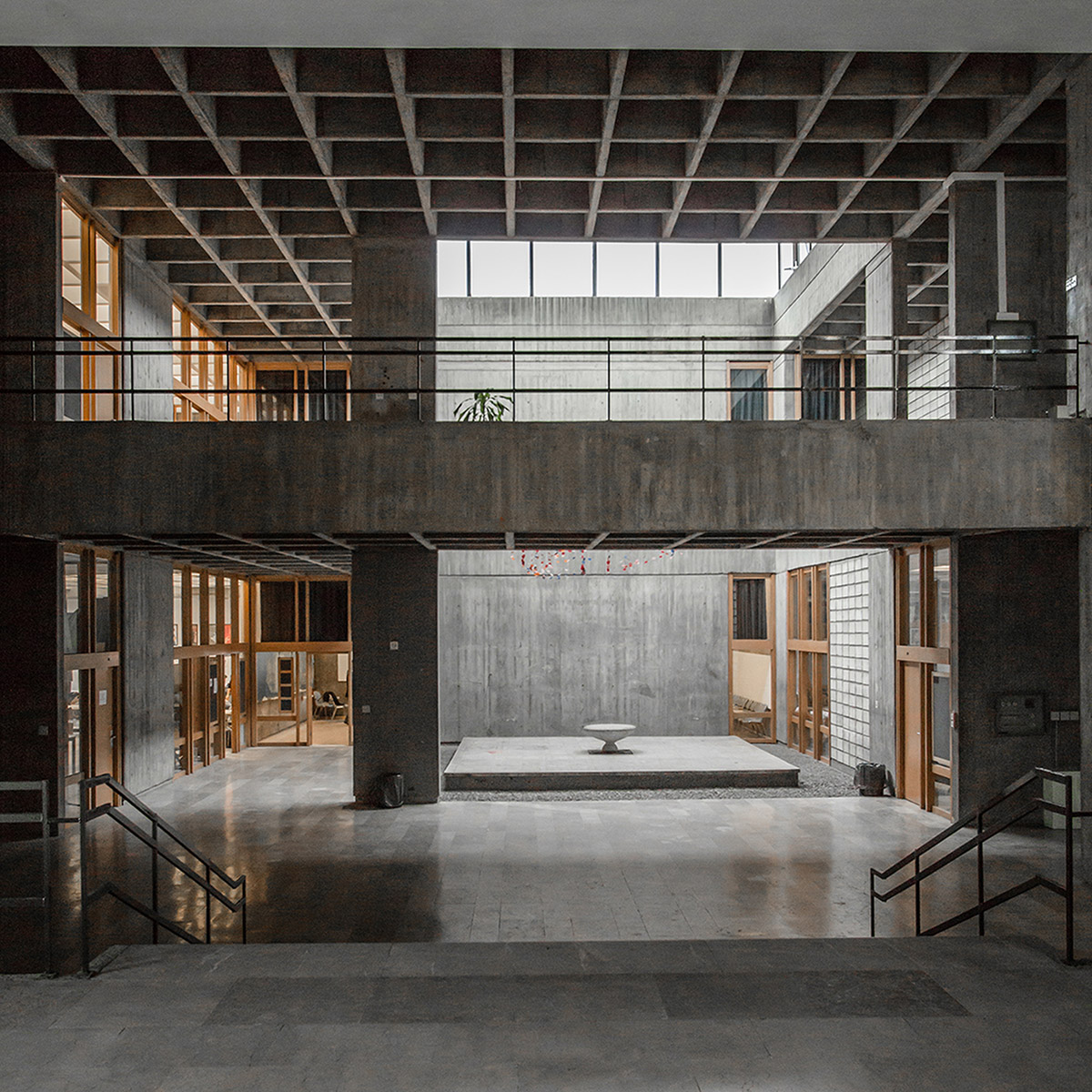
Interior of the Faculty of Architecture Building with Gobektasi. Image © Duygu Tuntas, courtesy of Getty Foundation
Middle East Technical University
Faculty of Architecture Building, Altuğ and Behruz Çinici, 1963, Ankara, Turkey
"The Middle East Technical University (METU), Faculty of Architecture Building located in Ankara is considered the premier example of modern architecture in Turkey. Originally housing administrative offices and the university’s central library, the building was conceived in the 1950s to reflect a political agenda that valued innovation and new models for learning. Designed by Turkish- born architect couple Altuğ and Behruz Çinici as a manifestation of a forward-looking nation, the building incorporates striking nods to the International Style, as well as regional interpretations of modernism."
"In 1966 the building became the Faculty of Architecture, which is highly regarded academically for its technical capability as well as its cultural heritage preservation program. This expertise is now needed for their own building, which faces the deterioration of modern elements and persistent energy performance problems resulting from the campus’s location on the harsh, earthquake-prone Anatolian steppe."
Grant support: $100,000
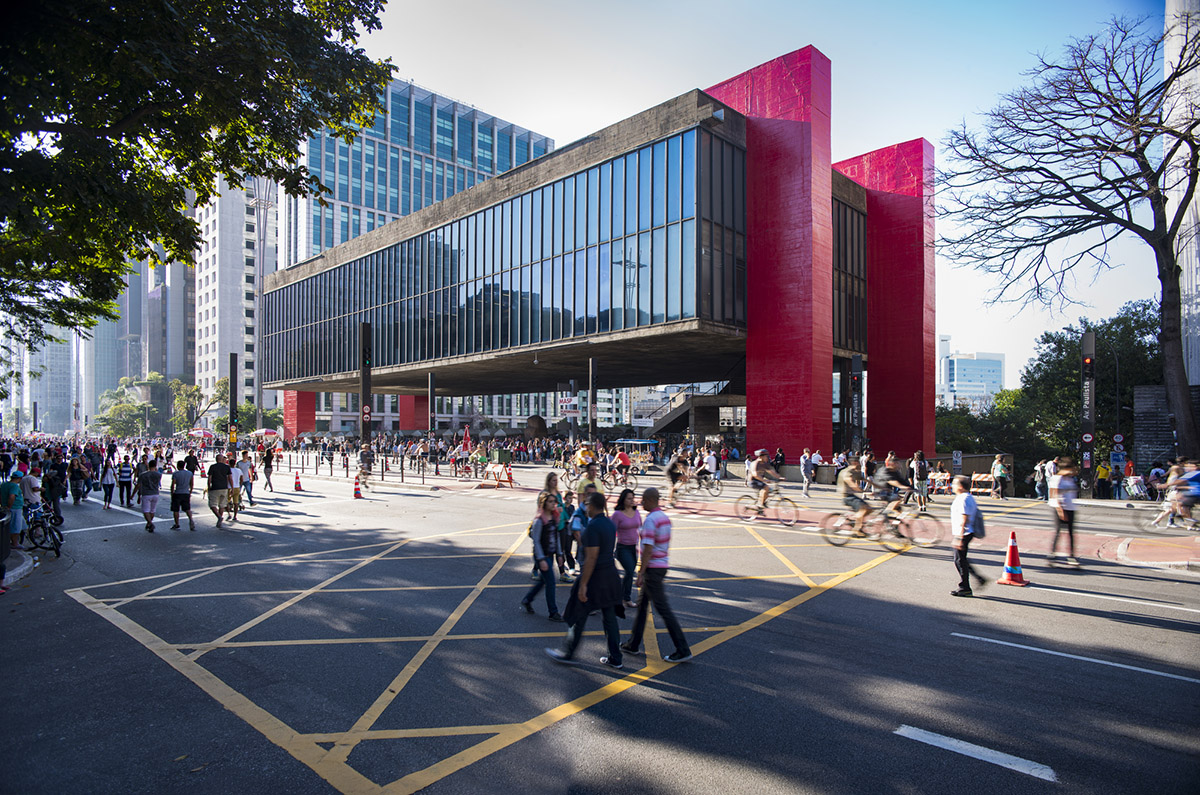
View of MASP on Avenida Paulista, 2016. Image © Eduardo Ortega, courtesy of Getty Foundation
Museu de Arte de São Paulo Assis Chateaubriand (MASP)
Museu de Arte de São Paulo Assis Chateaubriand, Lina Bo Bardi, 1968, São Paulo, Brazil
"An anchor of cultural life in the Brazilian city of São Paulo, the Museu de Arte de São Paulo Assis Chateaubriand (MASP) is a concrete and glass tour de force. Suspended on four massive pillars, the building shell hovers 26 feet above the ground and contains a total floor area of over 110,000 square feet."
"Designed by Lina Bo Bardi in 1957 and completed in 1968, the museum houses one of the most important collections of Western art in the Southern hemisphere. Bo Bardi was a visionary architect who believed that modern design should integrate local materials and surroundings. Originally from Italy, she relocated to Brazil in 1946 and put her experimental ideas into practice with her Casa de Vidro (Glass House) built in 1951 (Keeping It Modern grantee, 2016). Less than a decade later, Bo Bardi tackled MASP as the most ambitious project of her career."
Grant support: $150,000

St Peter’s College, Cardcross (exterior), 1958-1966. Image courtesy of The Glasgow School of Art Archives and Collection, courtesy of Getty Foundation
NVA (Europe) Limited
St Peter’s Seminary, Andy MacMillan and Isi Metzstein (Gillespie, Kidd & Coia architectural practice), 1966, Glasgow, Scotland
"Designed for the Catholic Archdiocese of Glasgow, St Peter’s Seminary was instantly recognized for its unabashedly brutalist use of in-situ and pre- cast panel concrete, which formed a modern homage to traditional religious forms— cloister, chapel, refectory, and cells. Architects Andy MacMillan and Isi Metzstein won the Royal Institute of British Architects’ Royal Gold Medal for Architecture and earned the highest ranking of significance in Scotland for a design that artfully rearranged traditional religious spaces in unexpected ways. Yet after only 14 years of use this training college for priests was shuttered, and deteriorating conditions landed the site on the World Monuments Fund’s most endangered cultural landmarks list in 2008."
"After 30 years of dormancy, many despaired that the complex was beyond repair and could not be salvaged. Now, after thoughtful research and a feasibility study, stewards are seeking a new life for the site as a performance space, cultural venue, and exhibition center. This creative adaptive reuse cannot happen, however, until the remaining structure is stabilized and conserved."
Grant support: £112,000
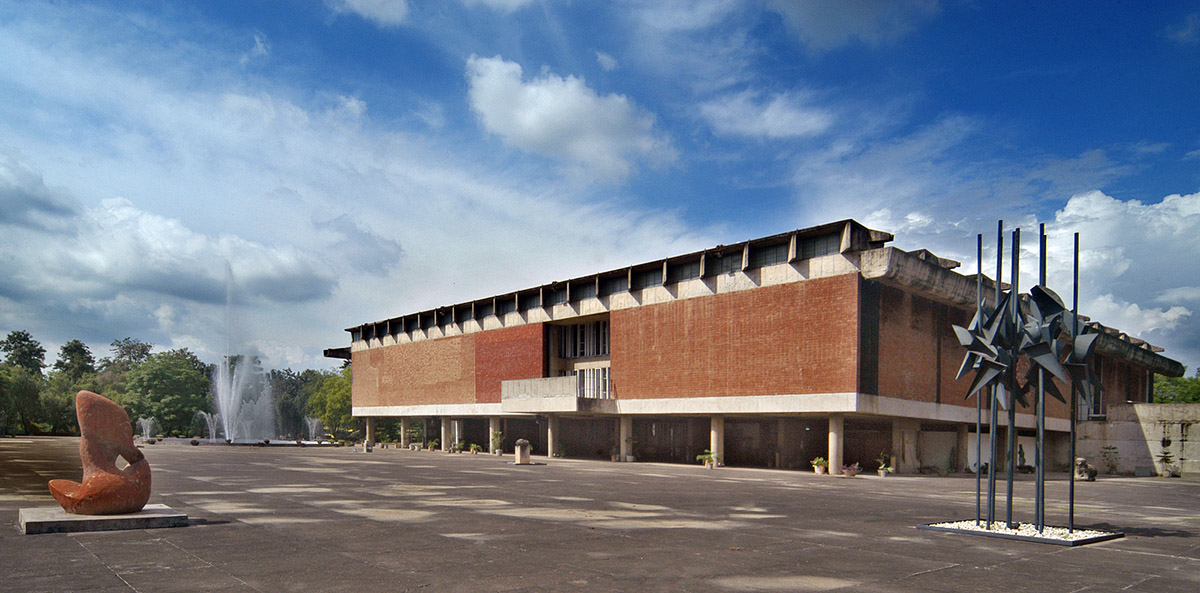
Forecourt of the Government Museum and Art Gallery. Image © SM Dhami, courtesy of Getty Foundation
"The Government Museum and Art Gallery in Chandigarh is a pivotal work by Le Corbusier, representing the culmination of the concept he developed with Pierre Jeanneret of a museum of the future. Their 1931 idea for a “Museum of Unlimited Growth” employed the design principle of a nautilus, radiating outward from the center to create a sense of unrestricted expansion. Le Corbusier also realized this idea at the Sanskar Kendra in Ahmedabad and the National Museum of Western Art in Tokyo."
"From the exterior, the Chandigarh museum, with its flattened spiral internal structure, appears to levitate on a field of pilotis. Le Corbusier’s use of exposed reinforced concrete and brick cladding for the museum’s facade symbolized the emergence of novel building typologies and the “arrival of the modern” in India as a newly independent nation. The Government Museum and Art Gallery is also recognized as a Grade-1 heritage site in India."
Grant support: $150,000

Price Tower. Image © Jessica Lamirand, CC BY- NC-SA 2.0, courtesy of Getty Foundation
Price Tower Arts Center Inc.
Price Tower, Frank Lloyd Wright, 1956, Bartlesville, Oklahoma
"The sole skyscraper of influential architect Frank Lloyd Wright stands out in the prairie landscape of Bartlesville, Oklahoma. Price Tower rises 19 stories tall and remains a commanding feature of the town’s modest skyline. For the interior spaces, Wright designed a mix of offices, shops, and residences that would generate revenue from residential and commercial leases. The arrangement succeeded, and the building remained in use, as designed, until its sale to Phillips Petroleum in 1981. Phillips renovated Price Tower’s mechanicals, plumbing, and electrical systems, and stabilized the exterior prior to donating the building to Price Tower Arts Center (PTAC) in 2002."
"Upon assuming ownership, the PTAC has taken important steps to preserve the tower as a living example of Wright’s architecture. An adaptive reuse plan for nine floors created hotel rooms and a restaurant, while preserving character-defining features. The Price Company’s executive offices and corporate apartment still remain largely in their original condition or have been restored to approximate their original state. In recognition of PTAC’s sensitive restoration and quality stewardship, Price Tower was designated a National Historic Landmark in 2007."
Grant support: $75,000
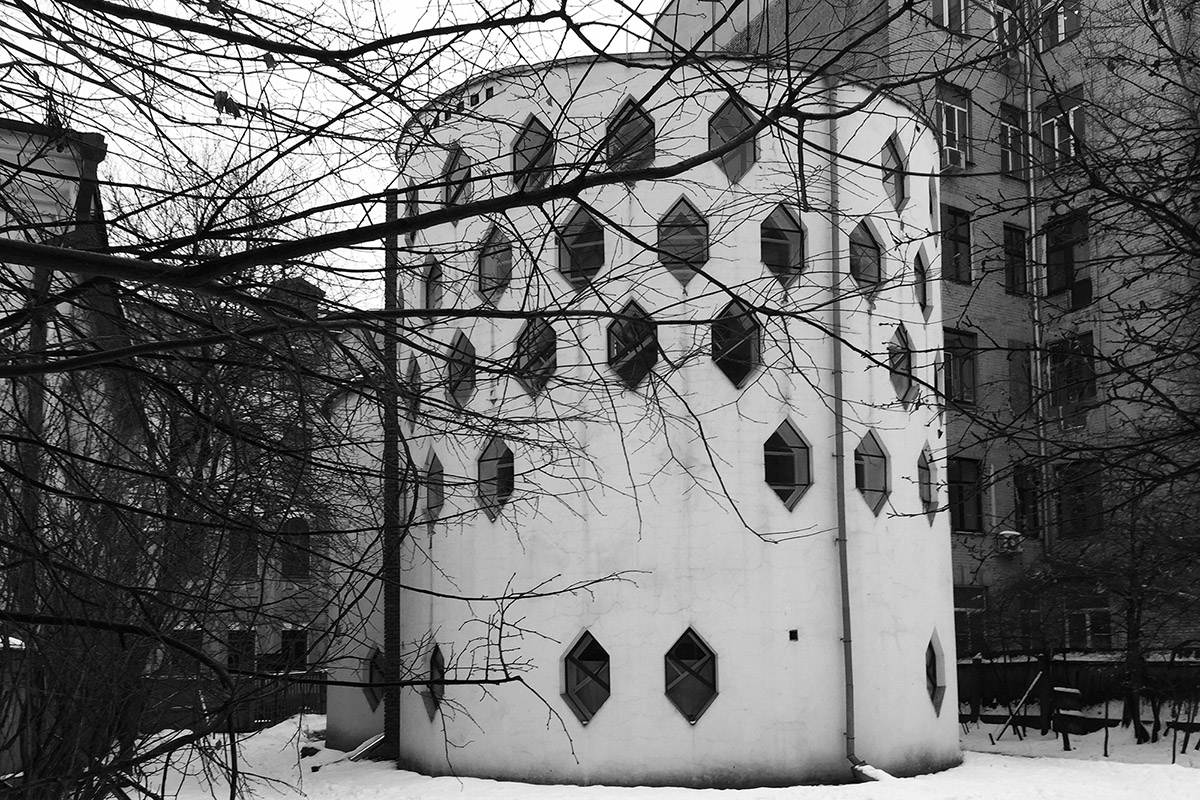
The Melnikov House. View from the courtyard. 2015. Image © Pavel Kuznetsov, courtesy of Getty Foundation
Schusev State Museum of Architecture
Melnikov House, Konstantin Melnikov, 1929, Moscow, Russia
"Moscow’s Melnikov House is a superlative example of Soviet avant- garde architecture and a masterpiece of structural ingenuity. Built as two intersecting cylinders, the house’s unconventional style reflects the boundary-pushing vision of architect Konstantin Melnikov, who designed the house as his studio and family residence. Two generations of the family lived in the building until the death of the architect's son in 2006, and it was transferred to the state in 2011 to be operated as a museum. The house and studio contain more than 14,000 objects, including original furnishings, paintings and drawings by Konstantin and Victor Melnikov, as well as architectural drawings and sketches. The site has now become the new State Melnikovs Museum—a branch of the Schusev State Museum of Architecture."
"Among the defining features of Melnikov’s design is the reliance on cylindrical shapes to provide both material economy and structural sturdiness. The house contains no interior load-bearing walls, allowing for large, unobstructed rooms and maximum light and space. The home also incorporates glass to striking effect, most notably with its 64 unique ‘honeycomb’ hexagonal windows that provide diffuse light throughout the interior."
Grant support: $120,000
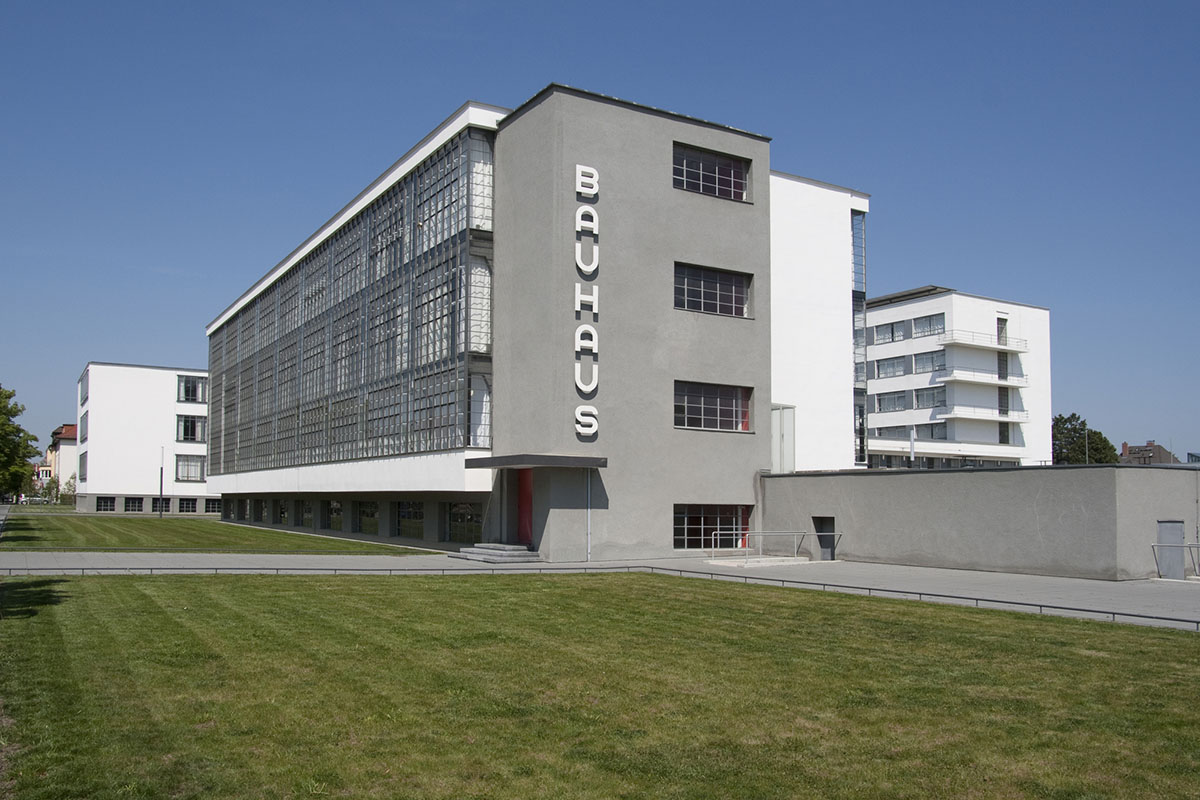
Bauhaus Dessau © Bauhaus Dessau Foundation. Image © Yvonne Tenschert, 2011, courtesy of Getty Foundation
Stiftung Bauhaus Dessau
Bauhaus building, Walter Gropius, 1925, Dessau, Germany
"Walter Gropius’s 1925 Dessau Bauhaus building is an icon of the modern movement: a sleek steel, concrete, and glass structure designed to house the most progressive school of art and architecture of the time. The building is both a clear statement of Gropius’s visionary aesthetic and a monument to some of the 20th century’s most influential artists, architects, and designers who served as Bauhaus faculty."
"The central Bauhaus building is a striking ensemble of three wings with two connecting bridges, varying in height and placed at 90 degree angles. Gropius relied on innovative engineering technologies to create a large skeleton of steel and reinforced concrete, brickwork, and mullioned steel windows. He achieved variation in the façades through restrained color difference between walls and the bold use of steel-framed glass to form curtain walls, one of the earliest examples of this characteristic feature of modernist architecture. UNESCO named the campus a World Heritage Site in 1996, and today it is open to the public as a museum and research center owned and managed by the Stiftung Bauhaus Dessau."
Grant support: €135,000
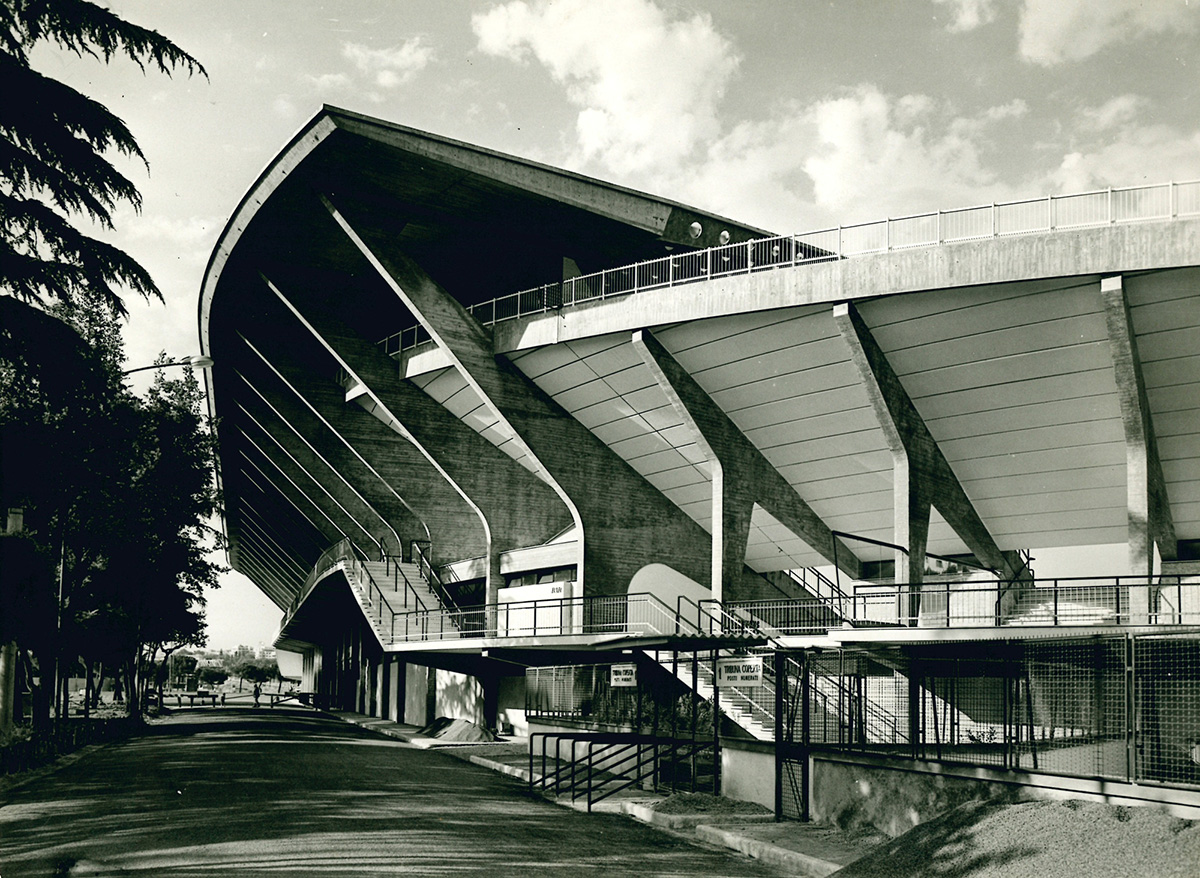
External view of Stadio Flaminio, 1960. Image © Oscar Savio. Courtesy Pier Luigi Nervi Project Association, Brussels, courtesy of Getty Foundation
Universitá degli Studi di Roma "La Sapienza"
Stadio Flaminio, Pier Luigi Nervi, 1960, Rome, Italy
"Designed for the 1960 Olympic Games in Rome, the Stadio Flaminio is one of Pier Luigi Nervi’s most celebrated buildings. Nervi was a prolific architect and engineer, who explored the boundaries of reinforced concrete with daring technological innovations and expressive concepts. By creating an arena that could hold 45,000 people, Nervi succeeded in a structural engineering feat for the time—transforming concrete into gravity-defying forms."
"Stadio Flaminio is one of many arenas and sports buildings designed by Nervi and reflects his numerous years of experience. With the stadium fully executed by the Nervi family’s architectural firm and designed in partnership with his son Antonio, Nervi had unique freedom to implement some of the structural engineering innovations in reinforced concrete and ferro- (or thin-) shell cement that he had been developing for decades. Although originally designed to host soccer matches, the venue has been used for other activities throughout the years, including rugby games and concerts. In 2011, despite its architectural and historic importance, the stadium was decommissioned due to declining use."
Grant support: €161,000
"Now that Keeping It Modern is in its fourth year, with earlier projects already completed, we are starting to see a positive response from the field," says Antoine Wilmering, senior program officer at the Getty Foundation.
"There is a domino effect of research findings and planning methodologies developed for one context being applied to other sites, which is a valuable outcome."
All of the new grants will support conservation planning and research, as successful interventions require the thorough assessment of current building conditions. The results will provide guidance for other projects in the future.
> via Getty Foundation
